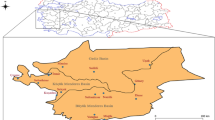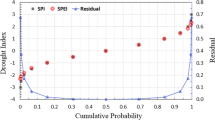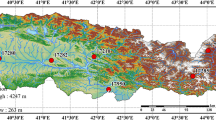Abstract
In this study, drought climatology and drought variability in the continental semi-arid and dry sub-humid Central Anatolia Region were analyzed using the annual and seasonal precipitation totals, Aridity Index (AI) and Standardized Precipitation Index (SPI), along with the long-term trends in their time-series. Trends in precipitation totals, 12-month SPI and annual AI series were statistically determined by applying the Mann–Kendall rank correlation test (M–K test) and its sequential analysis. The climatological probability of drought and wet events was evaluated according to different classes in the region. Annual AI values indicate that dry sub-humid climate was dominant from the mid-1990s to mid-2000s, and then semi-arid conditions were dominant from the mid-2000s to recent years. The climatological probability of monthly SPI values being severely dry is dominant mostly in the semi-arid and dry sub-humid central, south and east districts of the region. According to the M–K test, statistically significant decreasing trends were determined for annual total precipitation and the 12-month SPI series in Keskin, Pınarbaşı, Sarız, Ürgüp and Akşehir. Nonsignificant and statistically significant decreasing trends in spring precipitation were determined at approximately 67% of the stations and at Ilgaz, Kulu, Eskişehir, Keskin, Zara, Ürgüp and Sarız stations, respectively. With respect to the desertification in the Central Anatolia Region, the most vulnerable subregions for desertification processes are the Konya subregion and the Upper Kızılırmak subregion, mainly characterized by semi-arid and dry sub-humid environmental conditions.













Similar content being viewed by others
Data Availability
The data sets analyzed during the current study are available from the corresponding author on reasonable request.
Code Availability
None.
References
Arınç, K. (2016). Central Anatolia Region with its natural human, economic and political aspects. Biyosfer Araştırma Merkezi.
Bacanlı, Ü. G., Dikbaş, F., & Baran, T. (2011). Meteorological drought analysis case study: Central Anatolia. Desalination and Water Treatment, 26, 1–10.
Bayer-Altın, T. (2017). Trends and drought analysis of monthly and seasonal precipitation series in Nevşehir province, Turkey. In S. Şahinkaya, and E. Kalıpçı (Eds.), Cappadocia 2017 (Digital Proceeding of ICOCEE, pp. 1–10). Nevşehir Hacı Bektaş Veli University Publish.
Bayer-Altın, T. (2019). Drought analysis of KOP Region. In E. Aslan, M. Başalan, M. Arslan, Ü. S. Orhan, and Ö. Özdarıce, İ. Çakıroğlu (Eds.) Proc 7th International Symposium on Development of KOP Region (1st ed., pp. 563–583). Kırıkkale University Publish.
Bayer-Altın, T., Barak, B., & Altın, B. N. (2012). Change in precipitation and temperature amounts over three decades in Central Anatolia, Turkey. Atmospheric and Climate Sciences, 2, 107–125.
Brooks, N. (2004). Drought in the African Sahel: long-term perspectives and future prospects. Tyndall Centre Working Papers, 61. Retrieved 15 December 2021, from https://www.tyndall.ac.uk
Dai, A. (2011). Drought under global warming: A review. Advanced Review, 2, 45–65.
Dai, A., Zaho, T., & Chen, J. (2018). Climate change and drought: A precipitation an evaporation perspective. Current Climate Change Reports, 4, 301–312.
Erlat, E., & Türkeş, M. (2012). Analysis of observed variability and trends in numbers of frost days in Turkey for the period 1950–2010. International Journal of Climatology, 32, 1889–1898.
Erlat, E., & Türkeş, M. (2013). Observed changes and trends in numbers of summer and tropical days, and the 2010 hot summer in Turkey. International Journal of Climatology, 33, 1898–1908.
FAO. (2013). Climate-Smart agriculture sourcebook. Retrieved 15 September 2021, from https://www.fao.org/3/i3325e.pdf
FAO. (2021). The impact of disasters and crises on agriculture and food security. Retrieved 15 January 2022, from https://doi.org/10.4060/cb3673en
Häusser, M., Szymczak, S., Knerr, I., Bendix, J., Garel, E., Huneau, F., et al. (2021). The dry and the wet case: Tree growth response in climatologically contrasting years on the island of Corsica. Forests, 12, 1175.
Houghton, J. T., Jenkins, G. J., & Ephraums, J. J. (1990). Climate Change: The IPCC scientific assessment. Cambridge University Press.
Hulme, M. (1996). Climatic change within the period of meteorological records. In W.M. Adams, A.S. Goudie, A.R. Orme (Eds.) The Physical Geography of Africa (1st ed., pp. 88–102), Oxford University Press.
Hulme, M. (2001). Climatic perspectives on Sahelian desiccation: 1973–1998. Global Environmental Change, 11, 19–29.
IPCC. (2014). Climate Change 2014: synthesis report. In R.K. Pachauri, L.A. Meyer (Eds.), Contribution of working groups I, II and III to the fifth assessment report of the Intergovernmental Panel on Climate Change IPCC, Geneva, Switzerland.
IPCC. (2021). Climate Change 2021: The physical science basis. In Masson-Delmotte V., P. Zhai, A. Pirani, S. L. Connors, C. Péan, S. Berger, N. et al. (Eds.), Contribution of working group I to the sixth assessment report of the Intergovernmental Panel on Climate Change IPCC (1st ed., 2391 pp). Cambridge University Press.
Kelly, P. M., & Adger, W. N. (2000). Theory and practice in assessing vulnerability to climate change and facilitating adaptation. Climatic Change, 47, 325–352.
Kızılelma, Y., Çelik, M. A., & Karabulut, M. (2015). Trend analyses of temperature and precipitations in Central Anatolia. Türk Coğrafya Dergisi, 64, 1–10.
Konapala, G., Mishra, A. K., Wada, Y., & Mann, M. E. (2020). Climate change will affect global water availability through compounding changes in seasonal precipitation and evaporation. Nature Communications, 11, 1–10.
Kutiel, H., Hirsch-Eshkol, T. R., & Türkeş, M. (2001). Sea level pressure patterns associated with dry or wet monthly rainfall conditions in Turkey. Theoretical and Applied Climatology, 69, 39–67.
Le Treut, H., Somerville, R., Cubasch, U., Cubasch, Y., Ding, C., Mauritzen, A. et al. (2007). Historical overview of climate change. In S. Solomon, D. Qin, M. Manning, Z. Chen, M. Marquis, K.B. Averyt et al. (Eds.), Climate Change 2007: The Physical Science Basis, Contribution of Working Group I to the Fourth Assessment Report of the Intergovernmental Panel on Climate Change ( 1st ed., pp118–121). Cambridge University Press.
Lean, G. (1995). Down to earth: a simplified guide to the Convention to Combat Desertification, why it is necessary and what is important and different about it. Publisher UNCCD.
McKee, T.B., Doesken, N. J., Kleist, J. (1993). The relationship of drought frequency and duration to timescale. In Proceedings of the Eighth Conference on Applied Climatology (Vol. 17, No.22, pp.179–183). American Meteorological Society.
McKee TB, Doesken N. J, Kleist J. (1995). Drought monitoring with multiple timescales. In Proceedings of the Ninth Conference on Applied Climatology (pp. 233–236). American Meteorological Society.
MGM. (2022). Official statistics. Turkish State meteorological service. Retrieved 12 January 2022, from https://www.mgm.gov.tr/veridegerlendirme/il-ve-ilceler-istatistik
Millán, M. M., Estrela, M. J., & Miró, J. (2005). Rainfall components: Variability and spatial istribution in a Mediterranean Area (Valencia Region). Journal of Climate, 18, 2682–2705.
Mirzabaev, A., J, Wu., Evans, J., García-Oliva, F., Hussein, I.A.G., Iqbal, M.H. et al. (2019). Desertification. In P. R, Shukla, J. Skea, E. Calvo Buendia, V. Masson-Delmotte, H.O. Pörtner, D.C. Roberts et al. (Eds.), Climate Change and Land: an IPCC special report on climate change, desertification, land degradation, sustainable land management, food security, and greenhouse gas fluxes in terrestrial ecosystems. Retrieved 20 February 2022, from https://www.ipcc.ch/site/assets/uploads
Oruç, S. (2021). Visual and statistical inference of hourly and sub-hourly extreme rainfall trends Central Anatolia, Turkey case. Acta Geophysica, 69, 199–216.
Özfidaner, M. (2016). Trend analysis of the Central Anatolia Region precipitation data. Nevşehir Journal of Science and Technology TARGİD Special Issue, 5, 161–168.
Ramos, M. C. (2001). Rainfall distribution patterns and their change over time in Mediterranean area. Theoretical and Applied Climatology, 69, 163–170.
Şahin, S., & Türkeş, M. (2013). Contemporary surface wind climatology of Turkey. Theoretical and Applied Climatology, 113, 337–349.
Şahin, S., & Türkeş, M. (2020). Assessing wind energy potential of Turkey via vectoral map of prevailing wind and mean wind of Turkey. Theoretical and Applied Climatology, 141, 1351–1366.
Sarış, F., & Gedik, F. (2021). Meteorological Drought Analysis in Konya Closed Basin. Journal of Geography, 42, 295–308.
Sneyers, R. (1990). On the statistical analysis of series of observations. World Meteorological Organization Technical Note 43, Geneva.
Song, S. B., & Singh, V. P. (2010). Meta-elliptical copulas for drought frequency analysis of periodic hydrologic data. Stochastic Environmental Research and Risk Assessment, 24, 425–444.
Spinoni, J., Barbosa, P., Bucchignani, E., Cassano, J. J., Cavazos, T., Christensen, J. H., et al. (2020). Future global meteorological drought hot spots: A study based on CORDEX data. Journal of Climate, 33, 3635–3661.
Tatlı, H., Dalfes, H. N., & Menteş, S. (2004). A statistical downscaling method for monthly total precipitation over Turkey. International Journal of Climatology, 24, 161–180.
Taylor, M. (2015). The political ecology of climate change adaptation. Routledge.
Thornthwaite, C. W. (1948). An approach toward a rational classification of climate. Geographical Review, 38, 55–94.
Topuz, M., Feidas, H., & Karabulut, M. (2020). Trend analysis of precipitation data in Turkey and relations to atmospheric circulation: (1955–2013). Italian Journal of Agrometeorology, 2, 91–107.
Tramblay, Y., Llasat, M. C., Randin, C., & Coppola, E. (2020). Climate change impacts on water resources in the Mediterranean. Regional Environmental Change, 20, 83.
Turhan, E. (2016). Value-based adaptation to climate change and divergent developmentalisms in Turkish agriculture. Ecological Economics, 121, 140–148.
Turhan, E. (2021). Hands that adapt: seasonal labour migration, climate change, and the making of adaptable subjects in Turkey. In N. Natarajan and L. Parsons (Eds.), Climate change in the global workplace; labour, adaptation, and resistance (1st. ed., pp. 110–128). Routledge.
Türkeş, M. (1996). Spatial and temporal analysis of annual rainfall variations in Turkey. International Journal of Climatology, 16, 1057–1076.
Türkeş, M. (1999). Vulnerability of Turkey to desertification with respect to precipitation and aridity conditions. Turkish Journal of Engineering and Environmental Sciences, 23, 363–380.
Türkeş, M. (2003). Spatial and temporal variations in precipitation and aridity index series of Turkey. In H. J. Bolle (Ed.), Mediterranean climate-variability and trends, Regional Climate Studies (1st ed., pp. 181–213). Springer.
Türkeş, M. (2005). Climate of southern part of the Middle Kızılırmak sub-region (Cappadocia District) and its vulnerability to desertification. Aegean Geographical Journal, 14, 73–97.
Türkeş, M. (2007). Evaluation of Turkey’s tendency to drought, desertification and climate change. Pankobirlik, 91, 38–47.
Türkeş, M. (2010). Climatology and meteorology. Kriter Publisher.
Türkeş, M. (2013). The report of preparing the Turkey’s desertification map using climate data. The Republic of Turkey General Directorate of Combatting Desertification and Erosion. Retrieved 1 September 2021, from https://www.docplayer.biz.tr
Türkeş, M. (2017). Drought vulnerability and risk analysis of Turkey with respect to climatic variability and socio-ecological indicators. Ege Coğrafya Dergisi, 26, 47–70.
Türkeş, M. (2018). Impacts of climate change, Turkey's climate change adaptation requirements, vulnerability and risk assessments. In İ. Arı (Ed.), Climate change and development (1st. ed., pp. 37–68). Presidential Strategy and Budget Department.
Türkeş, M. (2020). Climate and Drought in Turkey. In N. B. Harmancioglu, D. Altinbilek (Eds.), Water resources of Turkey. World Water Resources (Vol. 2, pp. 85–125). Springer.
Türkeş, M. (2021). Can society’s climate change resilience be strengthened? Spektrum, 6, 95–101. (in Turkish).
Türkeş, M., & Akgündüz, A. S. (2011). Assessment of the desertification vulnerability of the Cappadocian district (Central Anatolia, Turkey) based on aridity and climate-process system. International Journal of Human Sciences, 8, 1234–1268.
Türkeş, M., & Erlat, E. (2003). Precipitation changes and variability in Turkey linked to the North Atlantic Oscillation during the period 1930–2000. International Journal of Climatology, 23, 1771–1796.
Türkeş, M., & Erlat, E. (2005). Climatological responses of winter precipitation in Turkey to variability of the North Atlantic oscillation during the period 1930–2001. Theoretical and Applied Climatology, 81, 45–69.
Türkeş, M., & Erlat, E. (2006). Influences of the North Atlantic Oscillation on precipitation variability and changes in Turkey. Il Nuovo Cimento, 29, 117–135.
Türkeş, M., & Sümer, U. M. (2004). Spatial and temporal patterns of trends and variability in diurnal temperature ranges of Turkey. Theoretical and Applied Climatology, 77, 195–227.
Türkeş, M., & Tatlı, H. (2009). Use of the standardized precipitation index (SPI) and modified SPI for shaping the drought probabilities over Turkey. International Journal of Climatology, 29, 2270–2282.
Türkeş, M., Sümer, U. M., & Demir, İ. (2002). Re-evaluation of trends and changes in mean, maximum and minimum temperatures of Turkey for the period 1929–1999. International Journal of Climatology, 22, 947–977.
Türkeş, M., Koç, T., & Sarış, F. (2007). Spatial and Temporal Analysis of the Changes and Trends in Precipitation Total and Intensity Series of Turkey. Cografi Bilimler Dergisi, 5, 57–73.
Türkeş, M., Akgündüz, A. S., & Demirörs, Z. (2009a). Drought periods and severity over the Konya Sub-region of the Central Anatolia Region according to the Palmer Drought Index. Coğrafi Bilimler Dergisi, 7, 129–144.
Türkeş, M., Koç, T., & Sarış, F. (2009b). Spatiotemporal variability of precipitation total series over Turkey. International Journal of Climatology, 29, 1056–1074.
Türkeş, M., Öztaş, T., Tercan, E., Erpul, G., Karagöz, A., Dengiz, O., et al. (2020). Desertification vulnerability and risk assessment for Turkey via an analytical hierarchy process model. Land Degradation and Development, 31, 205–214.
Ünal, Y. S., Deniz, A., Toros, H., & Incecik, S. (2012). Temporal and spatial patterns of precipitation variability for annual, wet, and dry seasons in Turkey. International Journal of Climatology, 32, 392–405.
UNCCD. (1995). The United Nations Convention to Combat Desertification in those Countries Experiencing Serious Drought and/or Desertification, Particularly in Africa, text with Annexes. UNEP.
UNEP. (1993). World atlas of desertification. The United Nations Environment Programme. UNEP.
Vogt, J.V., Naumann, G., Masante, D., Spinoni, J., Cammalleri, C., Erian, W. et al. (2018). Drought risk assessment. A conceptual framework. EUR 29464 EN. Publications Office of the European Union.
Willmott, C. J. (1977). Watbug: A fortran IV algorithm for calculating the climatic water budget. Publications in Climatology C. W. Thornthwaite Associates Laboratory of Climatology, Elmer.
WMO. (2012). Standardized Precipitation Index user guide. World Meteorological Organization, WMO-No. 1090. Retrieved 1 September 2021, from https://public.wmo.int
WMO. (2017). WMO Statement on the State of the Global Climate in 2016. Retrieved 12 October 2021, from https://public.wmo.int
Wong, G., van Lanen, H. A. J., & Torfs, P. J. J. F. (2013). Probabilistic analysis of hydrological drought characteristics using meteorological drought. Hydrological Sciences Journal, 58, 253–270.
Xoplaki, E., Gonzalez-Rouco, J. F., Luterbacher, J., & Wanner, H. (2004). Wet season Mediterranean precipitation variability: Influence of largescale dynamics. Climate Dynamics, 23, 63–78.
Acknowledgements
The authors would like to thank the Turkish State Meteorological Service for providing the monthly precipitation time series data for this study.
Funding
The authors declare that no funds, grants, or other support were received during the preparation of this manuscript.
Author information
Authors and Affiliations
Contributions
The author contributions are listed as follows: TBA and MT wrote the main manuscript text and prepared figures and tables. BN prepared the climate dataset. All authors have contributed equally to the manuscript.
Corresponding author
Ethics declarations
Conflict of Interest
The authors declare no competing interests.
Ethics Approval
Not applicable.
Consent to Participate
Not applicable.
Consent for Publication
All authors agree to publish.
Additional information
Publisher's Note
Springer Nature remains neutral with regard to jurisdictional claims in published maps and institutional affiliations.
Rights and permissions
Springer Nature or its licensor (e.g. a society or other partner) holds exclusive rights to this article under a publishing agreement with the author(s) or other rightsholder(s); author self-archiving of the accepted manuscript version of this article is solely governed by the terms of such publishing agreement and applicable law.
About this article
Cite this article
Bayer-Altın, T., Türkeş, M. & Altın, B.N. Evolution of Drought Climatology and Variability in the Central Anatolia Region, Turkey, for the Period 1970–2020. Pure Appl. Geophys. 180, 3105–3129 (2023). https://doi.org/10.1007/s00024-023-03321-y
Received:
Revised:
Accepted:
Published:
Issue Date:
DOI: https://doi.org/10.1007/s00024-023-03321-y




